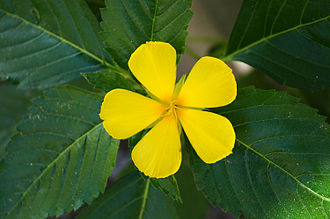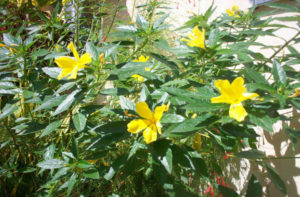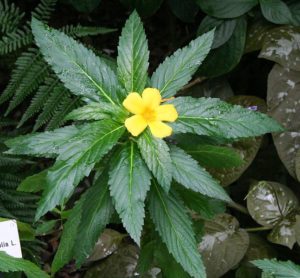 LEYENDA CIENFUEGUERA DE UNA BELLA FLOR, NUESTRA MESTIZA “MARI LOPE” & EL PIRATA FRANCES JACQUES DE SORES.
LEYENDA CIENFUEGUERA DE UNA BELLA FLOR, NUESTRA MESTIZA “MARI LOPE” & EL PIRATA FRANCES JACQUES DE SORES.
La Ciudad de Cienfuegos en Cuba tiene una flor que es símbolo que identifica a la ciudad, se llama “Marilope” y le acompaña una historia de nuestros colonos, indios y piratas, que de boca en boca y ya por tradición histórica se considera una creíble leyenda.
La Flor simbolo de Cienfuegos cuyo nombre científico es ‘Turnera ulmifolia’ o ‘aliso amarillo’, es una especie de planta de la familia Passifloraceae y crece erecta, con hojas dentadas oscuras y pequeñas flores de color amarillo anaranjado. Se conoce en Cuba como Marilope y en México como Clavel de Oro y es propia de la América tropical continental.
Tiene propiedades medicinales por lo que se emplea en remedios caseros contra el insomnio. La poción hecha con flores se utiliza para contrarrestar las descomposiciones estomacales e incluso la fiebre.
LA LEYENDA CIENFUEGUERA DE “MARI LOPE Y EL PIRATA JACQUES DE SORES”.
La leyenda de Marilope data de la segunda mitad del siglo XVI cuando la Bahía de Jagua fue visitada, entre otros muchos piratas, por el francés Jacques de Sores. Era terrible, le apodaban ‘el ángel exterminador’ y se acompañaba de navegantes violentos a su nivel.
Entre los colonos españoles que se habían asentado en la bahía cienfueguera había un hombre de apellido López que tuvo descendencia con una india nativa. Su hija heredó una belleza singular de rasgos europeos y tez mestiza. Le llamaron María. La niña creció y fue educada en la fe cristiana. Entre la pequeña población indígena Mari Lope comenzó a convertirse en un nombre sonoro que evocaba alegría. Sin embargo, este era un sentimiento efímero en la bahía al ver que se acercaban navíos por la costa.
Al llegar los piratas a las tranquilas aguas de Jagua para abastecerse de alimentos y restaurar sus naves, un hombre conocido como “Jean el Temerario” fijó su mirada en Mari Lope que había alcanzado esa edad en que la ingenuidad despierta los deseos del placer.
LEYENDA HISTORICA DE “MARI LOPE”.
Cuenta la leyenda que Jean mostró a Mari Lope su deseo con palabras piratas y recibió una rotunda negación. No puede un villano soportar tal desagravio así que intentó raptarla en tres ocasiones, pero la joven tuvo el apoyo de los colonos. En su cuarto intento por poseerla, Jean se presentó al rapto secundado por otros piratas de su banda. Al ver que una vez más sería frustrado su deseo, sacó su pistola y disparó.
Tras el disparo seco, Mari Lope cayó al suelo y una paloma voló. Antes de que Jean llegara hasta la joven para alzarse victorioso sobre su cuerpo, un rayo divino lo fulminó frente a todos los presentes.
En el lugar donde murió Mari Lope creció la flor amarilla que hoy los cienfuegueros protegen como un símbolo de identidad.
Esta leyenda se narra en Cienfuegos desde hace décadas y cada forma en contar el legendario pasaje historico aporta su sello de identidad. El aprendizaje más valioso de esta historia radica quizás en hacernos ver que el deseo obcecado y la violencia, no son un camino para llegar al amor.
 CIENFUEGOS LEGEND OF A BEAUTIFUL FLOWER, OUR MESTIZA “MARI LOPE” & THE PIRATE FRANCES JACQUES DE SORES.
CIENFUEGOS LEGEND OF A BEAUTIFUL FLOWER, OUR MESTIZA “MARI LOPE” & THE PIRATE FRANCES JACQUES DE SORES.
The City of Cienfuegos in Cuba has a flower that is a symbol that identifies the city, is called “Mari lope” and is accompanied by a history of our settlers, Indians and pirates, which from mouth to mouth and by historical tradition is considered a credible legend.
The Flower symbol of Cienfuegos whose scientific name is ‘Turnera ulmifolia’ or ‘yellow alder’, is a species of the Passifloraceae family plant and grows erect, with dark jagged leaves and small orange-yellow flowers. It is known in Cuba as Mari lope and in Mexico as Carnation of Gold and is typical of our tropical America.
It has medicinal properties so it is used in home remedies against insomnia. The potion made with flowers is used to counteract stomach decompositions and even fever.
THE CIENFUEGUERA LEGEND OF “MARI LOPE AND THE FRENCH PIRATE JACQUES DE SORES”.The legend of Marilope dates from the second half of the 16th century when the Bay of Jagua was visited, among many other pirates, by the Frenchman Jacques de Sores. It was terrible, he was nicknamed ‘the exterminating angel’ and was accompanied by violent navigators at his level.
Among the Spanish settlers who had settled in the Cienfueguera bay, there was a man by the name of López who had descendants with a native Indian. His daughter inherited a unique beauty of European features and mixed skin. They called her Maria. The girl grew up and was educated in the Christian faith. Among the small indigenous population, Mari Lope began to become a sonic name that evoked joy. However, this was an ephemeral feeling in the bay when ships were approaching along the coast.
When the pirates arrived in the calm waters of Jagua to stock up on food and restore their ships, a man was known as “Jean the Reckless” set his sights on Mari Lope who had reached that age when naivety awakens the desires of pleasure.
Legend has it that Jean showed Mari Lope his desire with pirate words and received a resounding denial. A villain cannot bear such relief, so he tried to kidnap her three times, but the young woman had the support of the settlers. In his fourth attempt to possess her, Jean presented himself to the abduction seconded by other pirates of his band. Seeing that once again his desire would be frustrated, he pulled out his gun and fired.
After the dry shot, Mari Lope fell to the ground and a dove flew. Before Jean reached the young woman to rise victoriously over her body, a bolt of divine lightning struck him in front of everyone present.
In the place where Mari Lope died, the yellow flower that the Cienfuegueros protect as an identity symbol grew.
This legend has been narrated in Cienfuegos for decades and each way of telling the legendary historical passage provides its hallmark. The most valuable learning in this story lies perhaps in making us see that the desire obscured and violence is not a way to reach love.
Agencies/ Wiki/ CiberCuba/ Gretchen Sanchez/ Extractos/ Excerpts/ Internet Photos/ YouTube/ Arnoldo Varona/ www.TheCubanHistory.com
THE CUBAN HISTORY, HOLLYWOOD.











